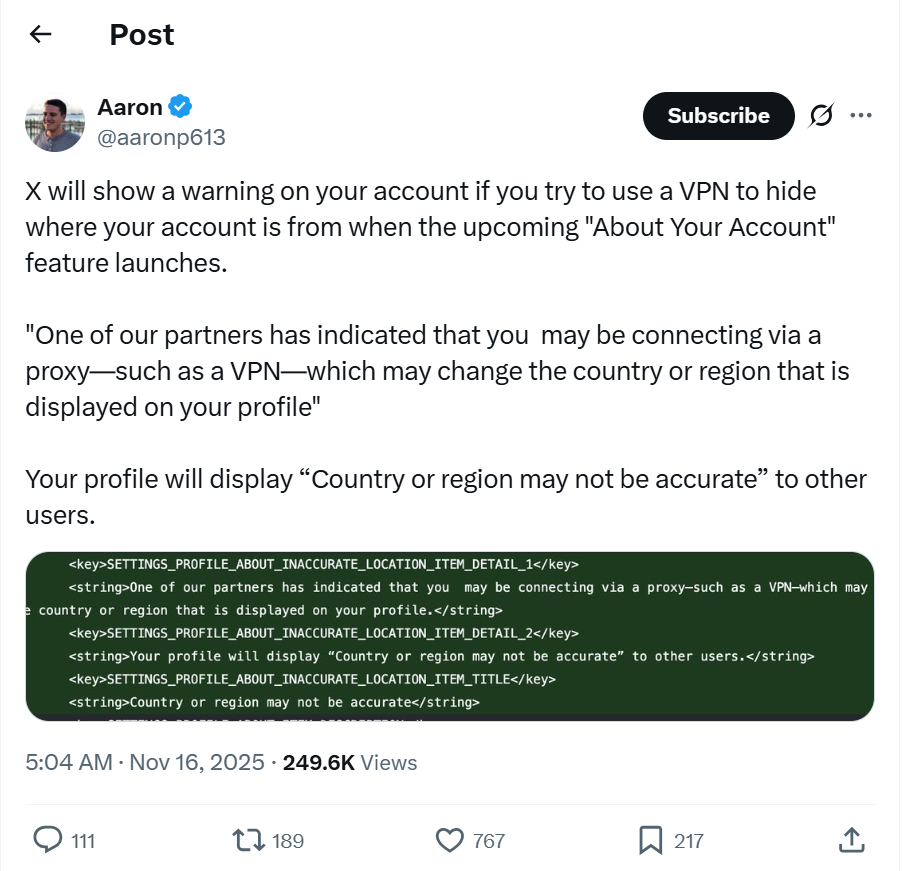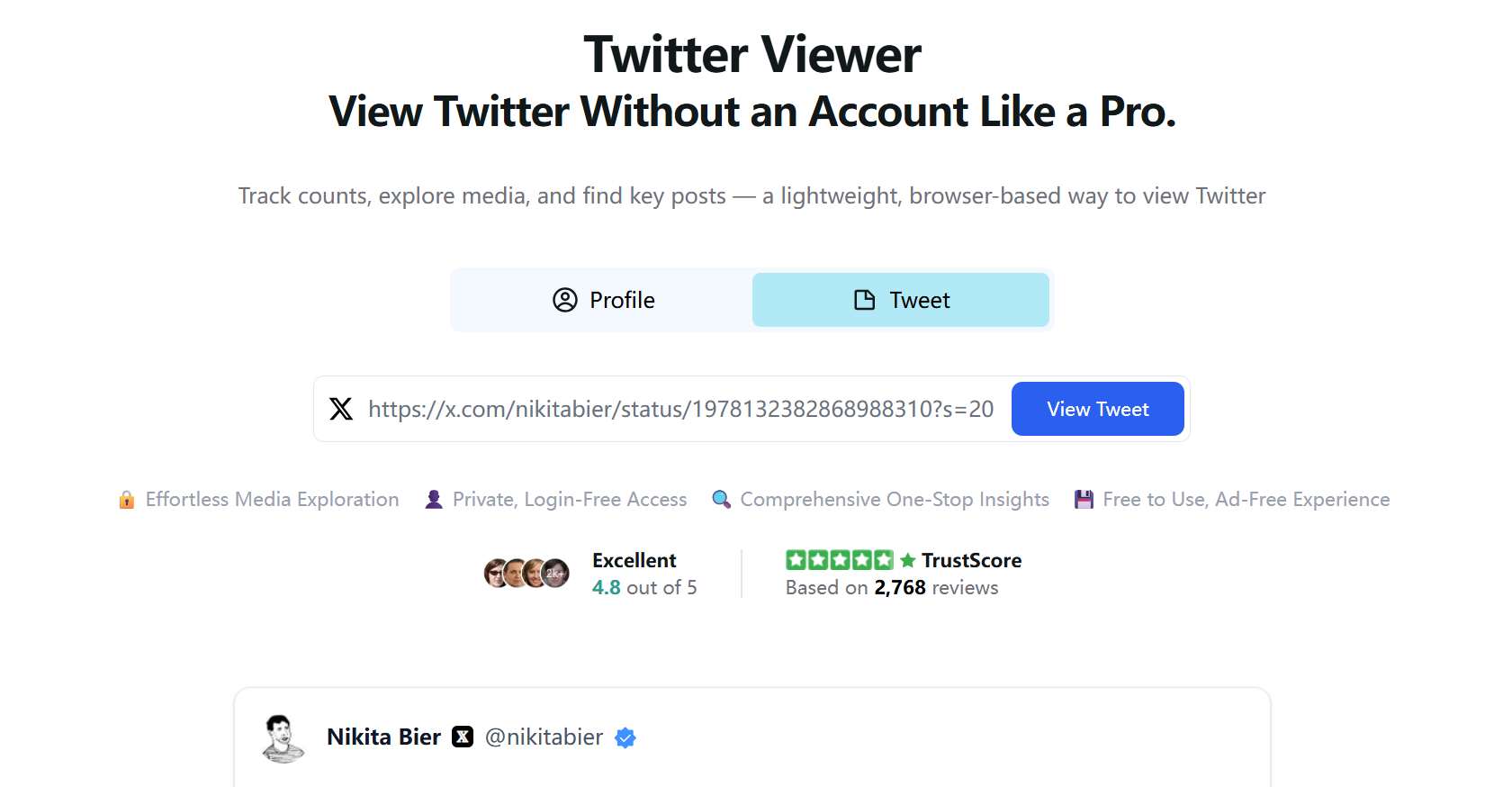By the end of 2025, a familiar question suddenly felt a lot less simple:
How do I anonymously view X?
For years, “anonymous” on X (formerly Twitter) mostly meant using Incognito mode, maybe pairing it with a VPN, and avoiding logging into your main account. But a series of leaks and news reports have started to change how people think about privacy on the platform.
In mid-November, MacRumors analyst Aaron Perris (@aaronp613) shared screenshots that appeared to come from an internal X experiment. In those images, a new “About this profile” section showed a warning that a profile’s “Country or region may not be accurate” when the system suspected the use of a VPN or proxy. A couple of days later, Social Media Today published one of the first news articles pulling this into a full story, suggesting that X was testing a feature that could indicate when an account appears to be hiding its true location via VPN.
Since then, other outlets such as TechRadar and TechSpot have picked up the story, interviewing VPN providers and raising obvious questions: What happens to users in hostile environments if VPN use becomes a visible signal on their profiles? What about journalists, researchers, or social media managers who rely on location masking as part of their work?
It’s important to stress one thing up front: X has not officially confirmed this feature. Everything we know comes from leaked UI, developer commentary, and media interpretation. But the direction of travel is clear enough that many users are no longer comfortable relying solely on VPNs or logged-in accounts to protect their privacy.
That’s where anonymous viewing comes back into focus—this time with much higher stakes.

The New Privacy Anxiety Around X
If X really does add a visible hint that “this account may be using a VPN,” it changes the emotional meaning of using privacy tools on the platform. A VPN stops being a purely defensive measure and starts to feel like a label attached to your profile.
For people who just scroll memes and sports takes, that might not matter. But for others, it absolutely does.
Think about a reporter watching political conversations in another country, a social-media manager quietly tracking competitor campaigns, an employee reading content their employer might frown upon, or simply someone in a restrictive region trying to follow global news. These are all situations where being unremarkable is a safety feature. Nobody wants a subtle but permanent “might be disguising their location” tag hovering over their activity.
Even if the feature never rolls out globally, the perception of risk is already here. Once people believe that VPN use on X could be surfaced or logged in new ways, they start looking for ways to read the platform without logging in at all.
Why Anonymous Browsing on X Has Gotten Harder
The problem is that X has quietly made anonymous browsing more difficult over the last couple of years.
A growing amount of content—threads, replies, full media, and especially anything tagged as “sensitive”—now sits behind a login wall. Even when the posts are technically public, non-logged-in users often hit a modal insisting they sign in before seeing more.
At the same time, X’s broader push for “authenticity” has meant more reliance on IP, device, and region signals. Even if you’re not being publicly flagged, a logged-in session still carries your account, your approximate location, and your behavior history with it.
Put simply: Incognito mode is no longer enough, and VPN + login no longer feels as anonymous as it once did—especially if VPN usage itself becomes a data point that X highlights.
That’s why more people are asking a more radical question:
Instead of trying to hide inside the official app or website,
Can I just view X without touching my account at all?
The Reality of “How to Anonymously View X” in 2025
There are still basically three approaches people try when they want to browse X as invisibly as possible.
1.Classic Way:
an Incognito or private window. This helps locally—no history, fewer cookies—but it doesn’t do anything to stop X from requiring a login or limiting what non-users can see.
2. VPN route.
This hides your IP and can sometimes bypass regional restrictions. But if X is experimenting with VPN detection and location warnings, that solution starts to look more like a trade-off than protection. Your connection is private at the network level, but the platform may still see that you’re connecting through something unusual.
3. New Trending Approach
More and more people are quietly adopting using a third-party anonymous viewer that fetches public content from X without requiring you to log in, identify yourself, or expose your device to X’s tracking scripts.
Industry comparison pieces—like Onstipe’s overview of free Twitter viewer tools—have started to treat these viewers as a distinct tool category, noting both the strong demand and the wildly inconsistent quality among different services. Some are slow; some break on media; some vanish overnight.
That inconsistency is exactly why one class of solution is starting to stand out: viewers that are built specifically for long-term, privacy-focused use rather than as disposable experiments.
Where Twitter-Viewer Fits In
Twitter-Viewer sits very deliberately in that category.
Instead of asking for a login, an API key, or any kind of session, Twitter-Viewer simply lets you paste a handle or a tweet URL and then loads the public content for you. From your perspective, you’re just visiting a regular website. From X’s perspective, there is no personal account to track, no profile to tag, and no user session to attach to a VPN warning.
You can read public timelines, individual tweets, replies, images, videos, and GIFs—even content that X normally hides behind a “sensitive media” screen for non-logged-in visitors. If the content is public, Twitter-Viewer can display it without asking you to sign in, verify your age, or toggle safety settings.
Crucially, it cannot and does not attempt to show protected or private content. If a post is locked behind a private account, a followers-only setting, or has been deleted, no viewer can legitimately bypass that—and Twitter-Viewer doesn’t try. Its value lies in removing the friction and tracking around public content, not in breaking X’s access rules.
This combination makes it genuinely useful for different kinds of users:
• A social media manager can quietly monitor a competitor’s campaigns from a neutral browser.
• A researcher can follow public discussions around a hashtag without creating a dedicated burner account.
• Someone simply curious about a trending topic can read the original tweets without being pulled into the app and its recommendation loops.

If you want a more step-by-step, practical angle on this, your earlier guide pairs nicely with this article:
How to View Twitter Without an Account (2025 Guide)
A Platform Moving Toward Transparency
Whether or not the VPN-flag feature ships exactly as the leaks suggest, X’s direction feels fairly consistent.
There’s a broader push toward transparency: more visible account history, stronger signals about where an account is based, and more emphasis on weeding out bots and inauthentic behavior. From a platform-integrity perspective, that all makes sense.
But there’s always a trade-off. The more information X surfaces to help people judge whether an account is “real,” the harder it becomes for those who genuinely need distance between their identity and their reading habits.
For the average user, the impact might be mild: a few more login prompts, the occasional warning label. For others, it fundamentally changes how safe they feel using the platform as themselves.
So, Is Anonymous Viewing Still Possible?
Yes—if you stop trying to be anonymous inside X and instead treat X as a source of public content that you access from the outside via a dedicated viewer.
That’s the mental shift happening right now. The question is no longer “How do I hide my trail while logged in?” but rather “How do I avoid creating a trail at all?”
Tools like Twitter-Viewer don’t solve every privacy problem on the internet, and they can’t magically unlock private content. But they do one very important thing: they decouple reading from being seen.
In an era where even using a VPN might someday become a visible part of your profile, that distinction matters more than ever.





